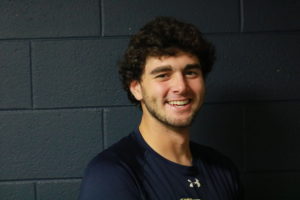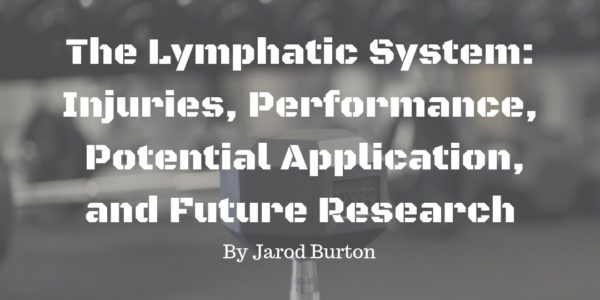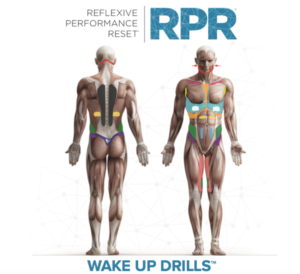*Note: This is a guest post, the first from DAC intern Jarod Burton. Although well stated in the article, I would like to emphasize that there is not yet enough research done on the lymphatic system as it relates to sport, RPR, fascia, or anything relating to those topics and sport performance or injury reduction, to draw any significant conclusions. This is simply a review of the current status of the research, the anecdotes we have heard, and how we plan to attack and expand the research moving forward.
The neurolymphatic system is beginning to surface in the sports world because of the recent claims demonstrating it may have the potential to increase muscular power, range of motion, and decrease the chance for injury in sport. The neurolymphatic system was first discovered in osteopathic practice, and later adopted by applied kinesiology. However, there is limited research conducted on the system and I’ve yet to come across any published sports-related research involving the neurolymphatic system. I’ve read and listened to several anecdotes that provide in-house testing and claim to prove that the neurolymphatic system has a positive effect on training and in sport. It is hypothesized the neurolymphatic system plays a role in sports and that this effect is brought about by palpating trigger points that align with lymph ducts on the body for 20-30 seconds. This is said to neurologically reset your body from a sympathetic state to a parasympathetic state. As a result, it is thought that the athletes' muscle reflex time will decrease, which increases muscular power output, range of motion, and reduces the risk for injury.
In the strength and conditioning world, the lymphatic system is often overlooked because our general knowledge of the system is that it is in charge of regulating the immune system. However, world renown strength coaches such as Cal Dietz and J.L Holdsworth, along with speed coach Chris Korfist (and others), have applied this method to their training to increase athletic potential in the weight room and reduce injuries during sport. They have formed an organization called RPR (Reflexive Performance Reset). Chris Korfist originally came across the concept of the neurological reset from a friend, Dan Fitcher, who attended a “Be Activated” conference developed by Douglas Heel (“The RPR® Story”). Douglas was primarily teaching medical professionals at the time, however, Chris saw a great opportunity to apply the “Be Activated” methods to the strength and conditioning world. After testing the methods and seeing results, Chris shared his findings with Cal Dietz who also saw amazing results (“The RPR® Story”).
What is a “Neurological Reset” and where does it come from?
This image is Dr. Chapmans original publication of the Lymphatic Reflexives: A Specific Method of Osteopathic Diagnosis and Treatment (1928).
The concept of the neurolymphatic system was first discovered in the 1920’s by Dr. Frank Chapman. Chapman claimed that through palpation of certain areas of the body, he could increase the flow and break up lymph fluids in the body. The increase of lymphatic drainage would then aid in the functions of bodily organs (Devine). After Chapmans death, his coworker, Charles Ownes, taught seminars about the Chapman Reflexes. His focus was to bring awareness of how the palpation points affect viscerosomatic tissue reflexes. He hypothesized that lymph stasis was the result of organ dysfunction (Devine). Roughly twenty years later, Dr. George Goodheart, who is known as the founder of applied kinesiology, begin to experiment with Chapman's findings. Goodheart discovered that immediately after palpating certain Chapman Reflexes, he could instantly take a “weak muscle” and make it “strong”. Goodheart applied Chapman’s findings with the practice of treating origin and insertions of muscles to eliminate deficiencies. For example, Goodheart claimed that he could fix scapular winging by pressing on “nodules found near the origin and insertion of the involved serratus anterior muscle” (1997). In the late 1970s, an osteopathic, Paul E. Kimberly, was the first person to teach a Chapman Reflex course at Kirksville College of Osteopathic Medicine. Kimberly viewed it more important to teach the reflexes as viscerosomatic reflexes (Chila, 2011).
How Does This Apply to Sport?
In 2004, Dr. John D. Capobianco stated that the Chapman Reflexes combat ganglion contractions, “which are believed to be congestions of fascia due to lymph stasis, secondary to visceral dysfunction” (Capobianco, 2018). Essentially, the Chapman Reflexes are described as a "gangliform contraction that blocks lymphatic drainage, causing inflammation in tissue distal to the blockage, and causes both visceral and somatic tissues to suffer” (Capobianco, 2018). The concepts of fascia congestion, and viscerosomatic dysfunction should be appealing to strength and conditioning coaches. Fascia congestion is another term for myofascial tightness. Stress on the body causes fascia tightness which has an effect on elasticity, strength, mobility, and circulation ("Myofascial Tightness"). There is no secret that these four components are thought to be the cause of muscle sprains and strains in one way or another. Furthermore, fascia runs from the tip of our toes all the way up to the head. Therefore, fascia is intertwined throughout our whole body, which means tightness in one area can result in tightness in other areas of the body, subsequently causing a negative chain effect to take place. The Chapman Reflexes combat these symptoms by effectively releasing the myofascia.
In addition, strength and conditioning coaches need to pay attention to the viscerosomatic system because it controls the functions of the organs. Somatic dysfunction affects biomechanics, posture, autonomic nervous system, respiratory/circulatory systems, and metabolic functions (Devine). This is key because a neurological reset on an athlete would theoretically enhance the efficiency of the respiratory and circulatory systems. For an aerobic athlete, it’s possible to see a decrease in race time and an increase in VO2 max. And for baseball athletes, it’s possible this improved efficiency MIGHT bring about the ability to recover more quickly and produce force more efficiently.
Application
The “Updated” version of Chapman’s original drawing
As was discussed earlier, here, I had the opportunity to talk to Cal Dietz one on one this past summer and have him perform an anti-rotation wake-up drill on me. Cal had me stand up, feet shoulder width apart. Then, he proceeded to put his arms on each of my shoulders as he demonstrated that he was going to provide torque on my shoulders and that I was supposed to resist him.
He counted down, “Three, two, one”, and began pushing on one shoulder and pulling on the other. I tried to resist him but instead found myself able to provide very little resistance. Cal then had me cross my arms and proceeded to pound up and down my erecter spinae muscles for roughly 20 seconds. After, Cal once again repositioned his hands on my shoulders.
“Three, two, one". I didn’t budge. At that moment I was shocked and amazed. It wasn’t the fact that I was weak in an anti-rotational movement, but rather that there was a delayed response between my neurological and muscular system. I was strong enough to resist the rotation, but not until after the reset was performed.
Cal then went on to explain how, in the first year that RPR was implemented into their warm-up routine, they had their soft tissue injuries reduced by half as a program.
Following the visit with Cal Dietz, I also had the privilege of visiting Patrick Love, who is the strength and conditioning coach for the Bakersfield Condors. We found Love through RPR’s website, as he was listed as a Level 2 RPR specialist there. Love was willing to take Brady and I through the entire RPR protocol. As we went through the trigger points, we saw a notable difference before and after the manual muscle tests, and in certain areas we saw an increase in range of motion.
Much like Dietz, Love, who has spent three seasons as the Condors Head Strength coach, has seen a noticeable injury reduction in his athletes since implementing RPR as a warm-up before their games. He reported as having had only one player with a soft tissue injury during that time, although he was quick to mention that he still doesn’t know how RPR works and that it could be as much of a placebo as anything.
As with after our visit with Dietz, I left amazed, but also confused, about how palpation of certain points of the body could just “magically" turn a muscle on.
Later in our trip, Brady and I saw that Chris Korfist was teaching a level one RPR certification course in Chicago, Illinois. We decided to sign up for the course and completed our level one certifications. However, we didn’t fully learn how or why RPR works. Level one was solely focused on the common trigger points that make the most notable differences and how to palpate them. Throughout the class, we were taken through each of the trigger points and given the opportunity to do before and after tests to see if we increased our range of motion in a certain stretch or were “stronger” in a manual muscle test. Much like Dietz and Love, Korfist also explained how, out of his three high school teams, where he coaches track and field, he hasn’t had a hamstring strain in seven years. In addition, over the course of a couple years, three of the local high school football teams he’s been involved with have only had two concussions. And out of those two, one kid got rocked, and the other kid was a freshman who was dared to run into the goal post at full sprint.
Upon returning home, I talked to my baseball coach at Cornerstone University and took him through RPR. He was sold and we started implementing it into our warm-ups at practice. Anecdotally, the athletes have been feeling better and we have seemingly seen fewer soft tissue injuries, however an official log of this was not kept, so more research and thorough tracking must be done before any claims are made.
Future Study
Recently, we have been granted the opportunity to work with Dr. James Sackett, who is a new professor at Cornerstone University and has several years of experience conducting his own research. Sackett was recently paid to do research for the Navy on under water scuba diving. He is now looking to switch his focus slightly onto sports related research. Likewise, I passionately care about helping athletes reach their full potential by learning how to train athletes more efficiently. As a result, we are currently conducting a study on RPR to see how it affects strength and power output, and whether it will have any significant impact on exit velocity and/or pitching velocity. We desire to help bring awareness about the neurolymphatic system, and create an environment where strength coaches can collaboratively come together and discuss the idea of how we can take better care of our athletes.
That’s it for today. Questions or comments? I can be reached via email at jburton2105@gmail.com.

Jarod Burton is currently interning at DAC Baseball. He is in his senior year of college, studying exercise science, at Cornerstone University. In the future, he plans to continue his involvement in sports related research and biomechanics as he strives to improve the training community.
-You can visit Cal Dietz’ Youtube Channel here for more info on the work and trials he’s done on RPR.
References
Mosier, A. D., & Kohara, D. (2007). Osteopathic medicine recall. Wolters Kluwer Health/Lippincott Williams & Wilkins.
DiGiovanna, E. L., Schiowitz, S., & Dowling, D. J. (2005). An osteopathic approach to diagnosis and treatment. Lippincott Williams and Wilkins.
Capobianco, J. D., Dr. (2018). Chapman’s Reflexes A Whole Body Approach. Lecture presented at American Academy of Osteopathy.
Journal Manipulative Physol Ther. [Abstract]. (1997, June 20). George Goodheart, Jr., D.C., and a History of Applied Kinesiology. doi:10/21/2018
Devine, W. H., Dr. (n.d.). Chapman's Reflexes And Viscero-Somatic Refexes – William H. Devine, DO – presentation 94 slides.pdf. Retrieved from https://www.scribd.com/document/365301338/chapman-s-reflexes-and-viscero-somatic-refexes-william-h-devine-do-presentation-94-slides-pdf
The RPR® Story. (n.d.). Retrieved from https://www.reflexiveperformance.com/rpr-story/
Fritz, S., Dr. (2013). Mosby's Fundamentals of Therapeutic Massage (Vol. 5) [5]. Elsevier Health Sciences.
Myofascial Tightness. (n.d.). Retrieved from http://www.therapyinmotion.net/wp-content/uploads/2012/03/Myofascial-Tightness.pdf
Chila, A. G. (2011). Foundations of osteopathic medicine. Wolters Kluwer Health/Lippincott Williams & Wilkins.


